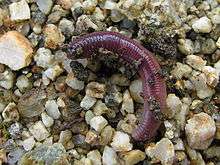Clitellata
| Clitellata Temporal range: Triassic–Recent[1] | |
|---|---|
 | |
| Earthworm | |
| Scientific classification | |
| Kingdom: | Animalia |
| Phylum: | Annelida |
| Class: | Clitellata |
| Subclasses | |
|
Branchiobdellae | |
The Clitellata are a class of annelid worms, characterized by having a clitellum - the 'collar' that forms a reproductive cocoon during part of their life cycles. The clitellates comprise around 8,000 species. Unlike the class of Polychaeta, they do not have parapodia and their heads are less developed.
Habitats
Most clitellates live on land, in freshwater or in the ocean.
Reproduction
All clitellata are hermaphrodites. During reproduction, the clitellum secretes a coat which hardens. The worm then creeps out backward from the coat and deposits either fertilized zygotes or both ovae and sperm into the coat, which is then packed into a cocoon. The zygotes then develop directly in the cocoon without passing through a larval stage (as opposed to other annelids, e.g. Polychaeta.) This mechanism is considered to be apomorphic (a newly derived characteristic rather than an evolutionarily ancestral one).[2]
Systematics
According to modern phylogenetic analyses, the Clitellata are considered to be a monophyletic subclade of the polychaetes.
Historically, the group was classified into the subclasses Oligochaeta and the Hirudinea. The oligochaetes contained the tubificids (Naididae, Lumbricidae, and Lumbriculidae - commonly the tube worms and the earthworms. The Hirudinea contained the leeches and the branchiobdellids. Modern analysis has revealed Branchiobdella and Hirudinea are two sister groups to the lumbriculids and they are daughter groups to the tree of oligochaetes. Hence, the terms Oligochaeta and Clitellata are considered synonymous.
- Branchiobdella - formerly in Hirudinea
- Hirudinea (leeches)
- Oligochaeta (earthworms - aquatic microdriles and terrestrial megadriles)
The Acanthobdellidea, a sister group to Hirudinea, are sometimes moved out of the Hirudinea as a distinct subclass, too. Overall, clitellate phylogeny is not well resolved.
Namely, the Acanthobdellidea, Branchiobdella and Hirudinea are monophyletic, but actually are embedded among the Oligochaeta, which are actually an evolutionary grade of lineages that are outwardly similar, but not actually very close relatives. In particular, the leeches and earthworms appear to be very close relatives. Two approaches are possible:[3]
- abolish Oligochaeta as traditionally delimited in favor of a number of smaller monophyletic lineages
- treat Oligochaeta and Clitellata as synonymous while splitting up the traditional "oligochaetes" into monophyletic lineages.
Footnotes
- ↑ Manum, S. B.; Bose, M. N.; Sawyer, R. Y. T. (1991). "Clitellate cocoons in freshwater deposits since the Triassic". Zoologica Scripta. 20 (4): 347. doi:10.1111/j.1463-6409.1991.tb00300.x.
- ↑ Reichardt (2006): pp.63, 67-68
- ↑ Erséus et al. (2008)
References
- Erséus, Christer; Wetzel, Mark J. & Gustavsson, Lena (2008): ICZN rules – a farewell to Tubificidae (Annelida, Clitellata). Zootaxa 1744: 66–68. PDF fulltext
- Reichardt, Anna Katharina (2006): Systematische Zoologie.
External links
| Wikimedia Commons has media related to Clitellata. |
- Brief description
- A Series of Searchable Texts on Earthworm Biodiversity, Ecology and Systematics from Various Regions of the World